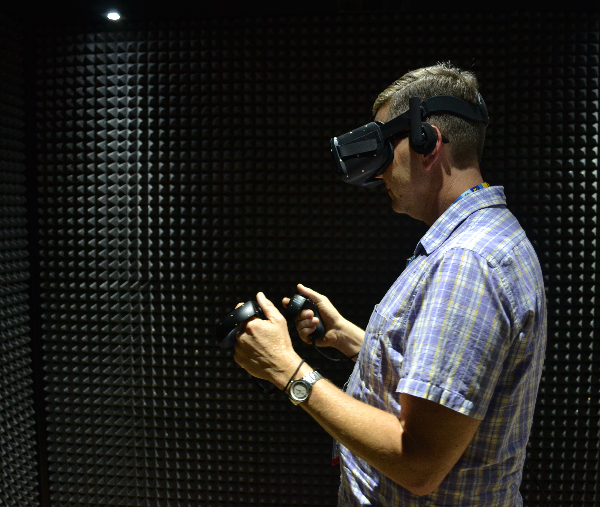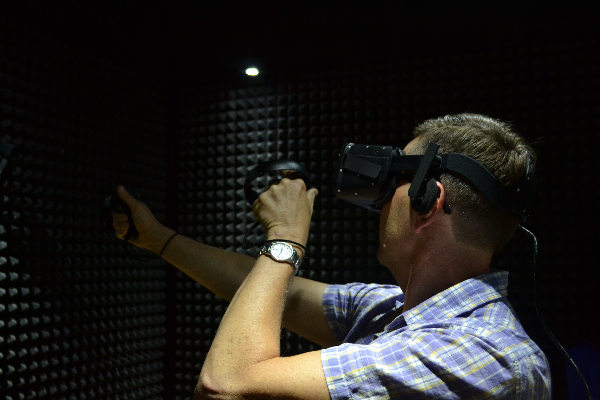The Oculus Rift Touch Controller, Hands On
If you took a game controller and reshaped it to be an extension of your hand, and then mirrored it so that each hand had one, you'd have the feel and the shape and the action of the Oculus Touch controller prototype known as Half Moon.
Now make them wireless, give them sensors and infrared LEDs so that not only your hand movements can be tracked, but your fingers too, so that in addition to using the buttons and triggers and analog sticks, you can point to, punch, grab, poke, pick up, shoot at and throw objects. Then, as if to leave nary a stone unturned, add some haptic feedback.
The Touch controller is a year away, scheduled to ship a full quarter after the first Oculus Rift ships, and Oculus CEO Brendan Iribe told me repeatedly that this is just the first generation, but for anyone frothing at the mouth over the possibilities of the Oculus Rift, the ideas being explored with Touch just might make you rabid.
For now, there are no games that make use of Touch. There is an Oculus Toybox, and it's full of...well, it's full of toys, wouldn't you know.
[Note: We were not allowed to take any pictures of the images in the Toybox.]
The demonstration was completely interactive. An (actual, human) Oculus representative, in the form of an avatar, presented himself to me within the VR experience. I could see representations of his head and his hands, including their actual movement, and he walked me through a few basics. He could see me in the same way. But he was in an entirely different room, and in truth, physically, we had our backs to each other, even though I was interacting with him face to face. (I learned this later.)
The Touch controllers manage to fit quite naturally in your hands. The triggers nest themselves at your middle fingers and the base of your palm, and you'll find the joystick at the edge of your thumb. I word it that way on purpose because in a way, the Touch, from a gaming action standpoint, extends your hands.
Get Tom's Hardware's best news and in-depth reviews, straight to your inbox.
You can see a representation of your hands, so when you point, the hand points. When you make a fist, you've got a fist. When you give a thumbs up -- you get the idea. Oculus executives believe that this will allow more in-game social interaction between players, or perhaps interaction in applications beyond gaming. There was a hint of this in the Toybox, and an Oculus representative told me that the demonstration does have the ability for two players to get right into the physical space of each other. Nevertheless, the avatar interaction felt genuine.
What's more, whether it was using the physical device, making the various gestures, or interacting, both with my Oculus host avatar or the objects in the Toybox, I innately just knew what to do. Oculus founder Palmer Luckey has talked about making hardware that "just disappears," and after wearing the final Rift hardware and using the Touch controller, I can affirm that Oculus is well on its way.
Back to the Toybox. I could pick up blocks and balls, and I could flick and punch big octagons. Hovering over an object to pick it up, I received a slight vibration that subtly told me that it was possible. Out came a tether ball, and we played like two schoolchildren on the playground. (My avatar host decided to pick up a ping pong paddle and hit the tether ball with that.)
The ping pong paddle came with ping pong balls. We picked them up and paddled them to ourselves and at each other.
A shooting gallery appeared, along with a choice of weapons. We started with a slingshot and knocked down ducks. Next we used guns. My avatar host tossed some rabbits into the air for me to shoot, and then threw boomerangs, and I shot them too.
He picked up a special laser gun and fired it, and made himself gigantic. Then he put huge, cartoonish characters in front of me, and I shot and punched them. Later, when my host was back to normal size, I shot him with the special laser gun and made him teeny tiny.
Suddenly there was a butane lighter in front of us and some roman candles and an M80. He lit a candle and -- here's where a piece of social interaction comes in -- he offered to light one of mine. We lit sparklers and the dynamite.
Once I punched a big blob, and it took us through a portal and into space; to another level, if you will.
Is The Touch Controller The Future Of VR Input?
Describing virtual reality is an impossible affair. I can talk about immersion, and what it means, and what it looks and feels like. I played at least a dozen new VR games this week, and I'd be hard-pressed to mesmerize you here with my words the way the experience enraptured me. It's my job to use words to make you see what I see and feel what I feel, but every time I attempt to do so with VR, I feel as if I utterly fail. Toybox and the Oculus Touch is probably another level of that. I'd like to tell you to just trust me, even though I know you won't, but -- trust me.
If virtual reality, especially in the form of technology like Oculus Rift, immerses you inside of a game, Touch may just let you reach out and grab it and control it.
It has the opportunity to make you not just a first person shooter or a third party observer traversing a game, but a more active participant in it. What if you could grab those gold coins, or shed off an attacker with a gut punch, or squash a bug, or pick up and toss a grenade.
If Oculus can make this device easy for developers to incorporate into a game experience, it will accelerate the pace at which players lose themselves in a game, causing the "virtual" part of VR to fade quietly into the background. (But I'm gushing now, aren't I. Virtual reality truly does have a tendency to sweep away your objectivity.)
Oculus representatives, including the company's CEO, keep saying it's a prototype, that it's version one, that there's a great deal more to do. We talked to Dan Hurd, the design lead of Lucky's Tale, which is one of the many delightful games that will be available for the Oculus Rift upon launch, and while his head is already churning through the possibilities with Touch, his team is focused only on getting its first game ready for launch. I suspect most of the developers creating games for the Rift are in the same boat.
In the demo room, the Touch controllers were tracked with two infrared sensors positioned on the back wall of the room, about three feet or so apart. That's more hardware, and the controllers are one more thing to track.
The Touch controllers use some form of Wi-Fi, but Oculus isn't saying much about it. The unspoken challenge is to keep input latency down while also keeping audio and head tracking latency at close to zero. That's a tall task. In the controlled demo, there wasn't much visible latency, but there was a little. For example, I was able to pick up an object, but the action wasn't precise, and this isn't Leap Motion-like skeletal finger tracking.
The haptics were there but were subtle, and I'm sure there's more to do, or at least more than can be done. When I punched or flicked objects, they reacted, but I didn't get any physical feedback (and thus, joy) out of my violence. More haptics, more feedback from my actions, more immersion, more joy.
Give it a year and let's see what Touch can become. I like its chances.
-
NightLight Great article. The revolution will come soon! I feel as excited as when I first played doom on my 386. Bring it on.Reply -
d_kuhn More progress, progress is good. I had the chance to play with a DK2 rift (first time) last week and was duly impressed with the level of immersion. Stepping back to the relatively low resolution of the DK2 display would take some adjustment, but the head tracking was so well done that it's a worthwhile tradeoff IMO. Hopefully the next version uses a 4k panel :-)Reply -
PaulBags Sounds expensive & in need of a good setting and space to use; so I would love to see these at arcades.Reply



